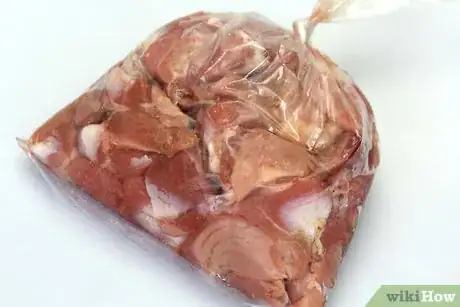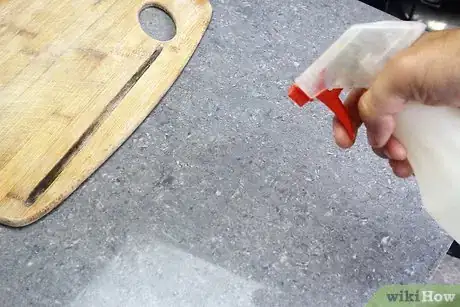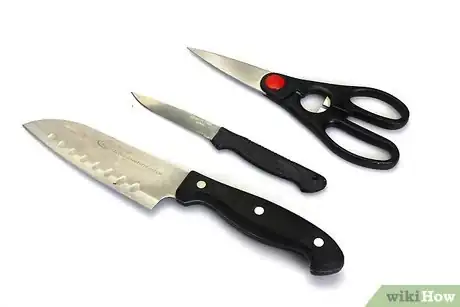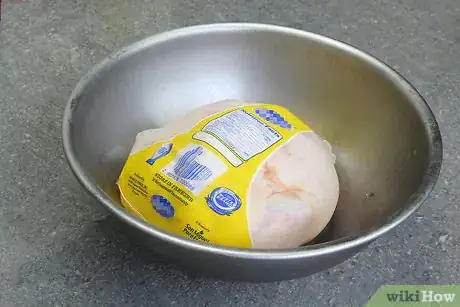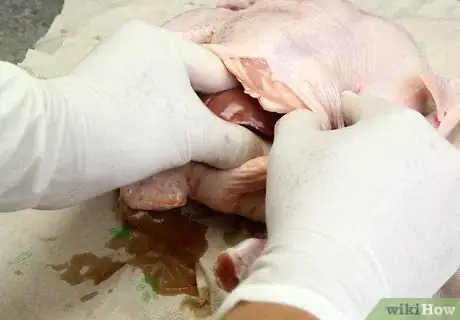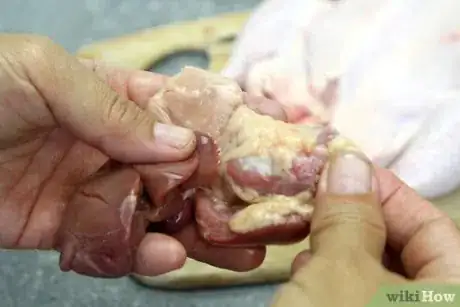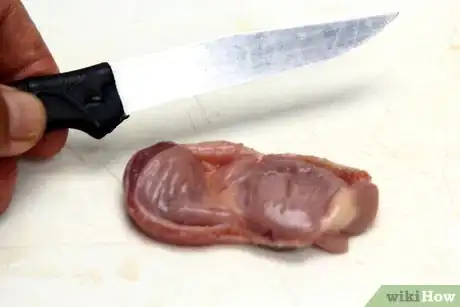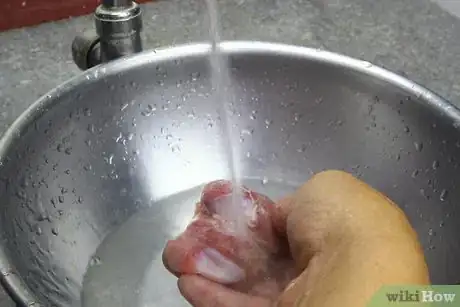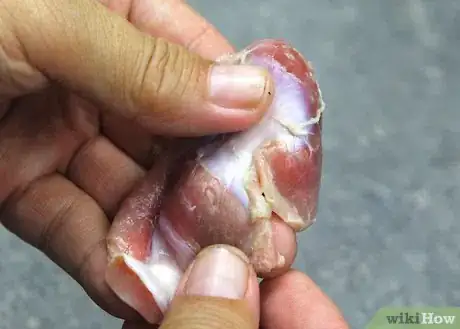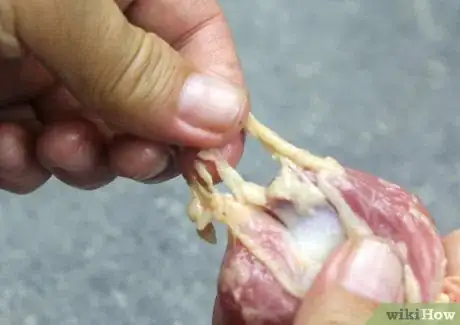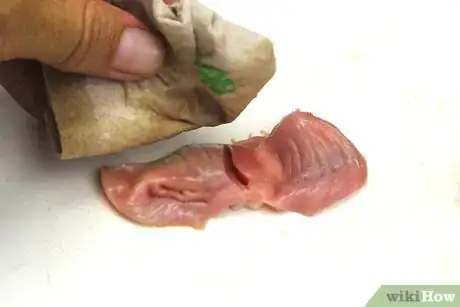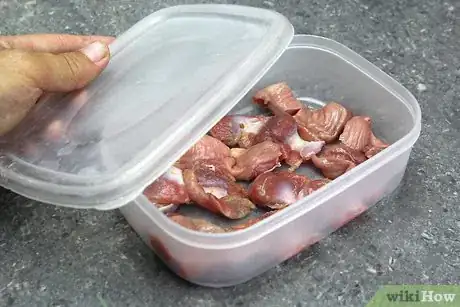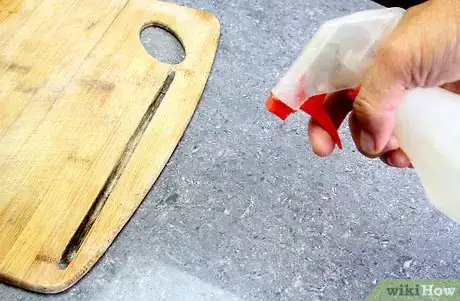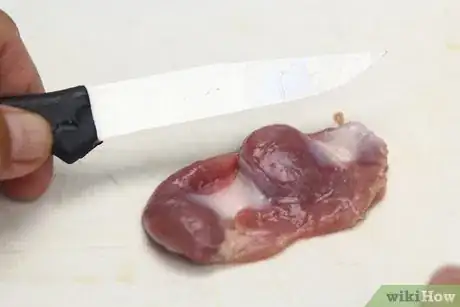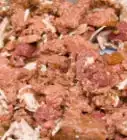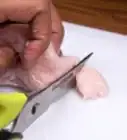This article was co-authored by wikiHow Staff. Our trained team of editors and researchers validate articles for accuracy and comprehensiveness. wikiHow's Content Management Team carefully monitors the work from our editorial staff to ensure that each article is backed by trusted research and meets our high quality standards.
There are 11 references cited in this article, which can be found at the bottom of the page.
This article has been viewed 59,542 times.
Learn more...
A chicken gizzard has a muscle-like consistency that can be quite tasty when cooked correctly. To clean your gizzard prior to cooking, start by sanitizing your workspace and tools. Locate the giblets package or cut the gizzard out of the chicken. Slice the gizzard in half and remove the interior sediment. Peel away the yellow interior membrane and the gizzard is ready to be cooked.
Steps
Setting Up Your Workspace
-
1Start with a quality chicken and/or gizzards. You can either raise your own chickens for slaughter or purchase your chicken products at a grocery store or local butcher shop. They are also sometimes available at farmer’s markets. It’s even possible to order gizzards online via various grocery delivery programs, including some on Amazon.[1]
-
2Prepare your workspace. Wipe down your countertop, butcher block, or cutting board with a clean, wet towel. Locating your workspace near a sink is a good idea as it makes it easier to wash your hands and rinse off items as needed.[2]Advertisement
-
3Select the proper tools. Many people believe that it is a good idea to use your sharpest knives to butcher a chicken and to clean out a gizzard. Others argue that the grit within the gizzard can damage sharp knives and that only dull ones should be used. It is your choice as to what you select, but be aware that it may be more difficult to remove the thin membrane with a dull knife.[3]
- If you choose to use a chopping board, make sure that it is one that is heavy and won’t move while you are cutting into the gizzard. Plastic cutting boards are usually more sanitary than wood ones, but they have a tendency to be lighter and move more.
-
4Clean your utensils and hands. Rinse off your knives with soap and water before placing them on your work area. As a last step, keep the water on warm and lather your hands up with soap. Rinse your hands under the water until they are completely clean. Dry them with a fresh towel.[4]
- If you choose to wear gloves, make sure that they are well-fitting. Gloves that are too loose can make it more difficult to hold on to the gizzard.
-
5Thaw the chicken. If you bought a whole chicken frozen, place it in the refrigerator until it is fully thawed. It should take 24 hours of fridge thawing time per five pounds of meat. It is also possible to thaw the gizzards by placing them in a sealed plastic bag and then submerging them in a sink filled with cold water. Drain and refill the sink with cold water every 30 minutes until the gizzards are thawed. Estimate 30-60 minutes of thawing time per pound using the cold water method.[5]
- If you thaw your gizzards in the sink, make sure that the plastic bag stays sealed to prevent the spread of potentially dangerous bacteria or germs. Wipe down the sink with an antibacterial cleaner after use.
-
6Remove the giblet package. If you bought a chicken whole, after it is defrosted, you’ll want to reach inside the cavity and remove the plastic giblet package. This package will contain the neck, kidneys, heart, and gizzards. Pull out the gizzards to use.[6]
-
7Locate the gizzards inside the bird. If you are butchering a fresh chicken, then you will want to look for the gizzard at the end of the intestines. It will almost look like a second stomach. Reach your hand into the interior cavity and gently lift the gizzards out, taking some of the intestine with you if necessary. Just make sure to keep the intestines intact or you could risk polluting the meat and gizzard.[7]
Preparing the Gizzards
-
1Place the gizzards on the cutting board. Go slowly and be very careful as they can be a bit slippery. If the gizzards are covered in blood or debris, then rinse them with water before setting them down.[8]
-
2Cut the gizzard in half lengthwise. Hold the gizzard down firmly, but not enough to change the overall shape. Take your knife and cut the gizzard in half, slicing all the way through until you have two separate pieces. It is best to make just one smooth cut per gizzard.
-
3Wash out the interior of the gizzard under water. Once you make the incision, you will see a variety of debris inside the gizzard. Rinse out the inside of the gizzard, moving the water stream around in order to clean out all of the debris. It may take you several minutes to complete this process. Keep going until the flesh looks totally clean.[9]
- This cleaning process is very important because the gizzard is a part of a chicken’s digestive system and can have matter inside that is not safe for human consumption.[10]
-
4Use your fingers to find any extra sediment. As you hold the gizzard under water, it might be helpful to use your fingers to rub against the flesh of the interior to loosen any stubborn debris. Keep gently scrubbing until you feel that everything is smooth.[11]
- Be aware that the inside of a gizzard can appear to be brown or black due to the presence of sediment. This is a natural and not a cause for a concern if the gizzard is properly rinsed.
- The debris can sometimes be rather larger and include pieces of rock and grass.[12]
-
5Trim the lining away. When the interior of the gizzard is clean, you will see a yellow-tinted lining in the inside. Remove the lining by peeling it away from the rest of the gizzard’s flesh. It should come off fairly easily, but you may need to make a slight cut at the side of the gizzard to start the separation process.[13]
- The lining can be differentiated from the edible flesh because it will feel rubbery in texture.
Storing and Using the Gizzards
-
1Dry the gizzards. When the lining has been removed and discarded, rinse the gizzards again with water. Then, place them on a fresh cutting board, patting them dry with paper towels. Keep going until there is very little moisture visible on the skin of the gizzard.[14]
-
2Store them in a sealed container. Place the cleaned gizzards in a container until you are ready to cook them. Make sure that the container is tightly sealed and is clean on the inside to avoid cross-contamination.[15]
-
3Wash all utensils, the workspace, and your hands. Go through and wash all of your knives and cutting boards under warm water and soap or place them in the dishwasher under the sanitize function. When everything else is clean and wiped down, go ahead and do a final hand wash.[16]
- Don’t forget to wipe down the counter space with a cleaner.
-
4Cook the gizzards. You can prepare gizzards in a variety of ways, including boiling, baking, frying, or simmering. Experiment with different methods until you find one that you prefer. Many people place the gizzards in brine for at least a few hours before cooking in order to improve the texture. Look for a great brine recipe online and then adapt it to suit your personal tastes.[17]
-
5Go slowly. Throughout the entire preparation and cooking process, make sure to take your time. Otherwise, you might injure yourself with a knife or damage the gizzard beyond use. It is better to go slowly and create an edible final product. If it is your first time cleaning gizzards, buy a few extra just to be on the safe side.[18]
Community Q&A
-
QuestionCould I eat the giblet organs, too?
 Community AnswerYes; the liver and heart are also edible (and quite tasty).
Community AnswerYes; the liver and heart are also edible (and quite tasty).
Warnings
- Keep everything clean in order to avoid contracting or transferring a food borne illness, such as salmonella.⧼thumbs_response⧽
Things You’ll Need
- Chicken gizzards
- Knife
- Cutting board
- Soap
- Water
- Storage containers (optional)
- Brine (optional)
References
- ↑ https://delishably.com/meat-dishes/gizzards
- ↑ https://howlingduckranch.wordpress.com/2009/07/15/butchering-chickens/
- ↑ https://delishably.com/meat-dishes/gizzards
- ↑ http://www.recipetips.com/kitchen-tips/t--1090/cleaning-chicken.asp
- ↑ https://www.fsis.usda.gov/wps/portal/fsis/topics/food-safety-education/get-answers/food-safety-fact-sheets/safe-food-handling/the-big-thaw-safe-defrosting-methods-for-consumers/CT_Index
- ↑ http://www.thekitchn.com/what-are-giblets-65220
- ↑ http://www.theselfsufficienthomeacre.com/2013/02/how-to-butcher-a-chicken-5.html
- ↑ http://franticfoodie.com/how-to-cook-chicken-gizzards/
- ↑ http://www.seriouseats.com/recipes/2010/07/the-nasty-bits-what-i-didnt-know-about-gizzards.html
- ↑ http://nosetotailapp.com/blog/chicken-offal
- ↑ http://www.outdoorlife.com/blogs/cast-iron-chef/how-prepare-and-cook-waterfowl-gizzards#page-5
- ↑ http://www.seriouseats.com/recipes/2010/07/the-nasty-bits-what-i-didnt-know-about-gizzards.html
- ↑ http://www.theselfsufficienthomeacre.com/2013/02/how-to-butcher-a-chicken-5.html
- ↑ http://franticfoodie.com/how-to-cook-chicken-gizzards/
- ↑ http://www.theselfsufficienthomeacre.com/2013/02/how-to-butcher-a-chicken-5.html
- ↑ http://www.recipetips.com/kitchen-tips/t--1090/cleaning-chicken.asp
- ↑ http://www.stabroeknews.com/2016/the-scene/tastes-like-home/08/06/whats-cooking-liver-gizzards/
- ↑ http://www.theselfsufficienthomeacre.com/2013/02/how-to-butcher-a-chicken-5.html
